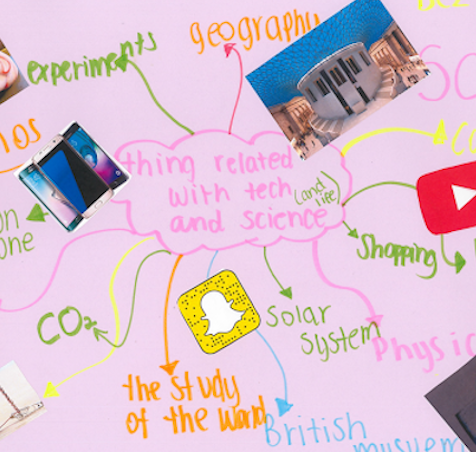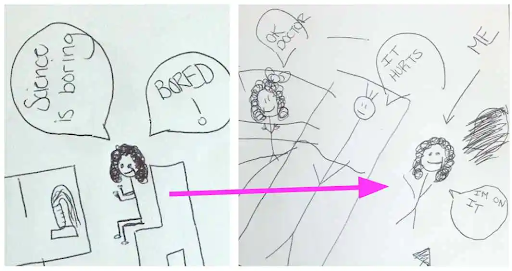Justice-Oriented Pedagogies for Informal Science Learning
By Day Greenberg and Angela Calabrese Barton, University of Michigan

The YESTEM Project: Science Learning + Partnerships to Support Equitable STEM Pathways for Minoritized Youth (U.S. PI: Angela Calabrese Barton, UK PI: Louise Archer)
"When I’m here [at science club], I feel like I can be me. Like, it’s not judgmental here. We get to learn and do things and experiments and make things that are real, and they help people...When people see [my light-up dog leash] and they use it, they’ll say I did a good job, and I stood up for myself. They’ll say, I worked hard, and I’m really good at science, and like caring for dogs and people. It’s weird because I didn’t even like science, but it felt different here to make something for dogs. (Mandana, age 11)"
Introduction
Mandana’s comments offer insight into how and why engaging in Informal Science Learning (ISL) environments can benefit youth, providing crucial and powerful access to science opportunities. Her quote presents a developing sense of self in science, with positive feelings about her afterschool science club. It also highlights how she used science to improve her self-esteem and to overcome the poor self-image she had had in sixth grade science class, where she said she often felt “invisible.”
Informal science, technology, engineering and mathematics (STEM) learning (ISL) settings are a promising way of disrupting current systemic patterns of underrepresentation in STEM. However, while informal STEM programs and practices may be accessible to a wide range of audiences, the learning experiences themselves may welcome some participants, while excluding and alienating others.
How youth enter ISL is partly a result of their own experiences and their family’s and community’s cultural practices. If STEM programs and activities do not encourage and support youth in ways that leverage their cultural experience, their opportunities for meaningful learning may be foreclosed. Thus, ISL educators’ practices play an important role in whether and how youth are welcomed into STEM.
Project Development Process
In the YESTEM Project (Youth + Equity + STEM), we sought to co-investigate and co-design justice-oriented approaches and tools to support youth’s learning and engagement in STEM as they moved toward STEM-agentic lives. Together with youth, educators, and researchers using participatory and design-based approaches, we explored justice-oriented ISL practices that:
● Welcome and legitimize youth’s lives, communities, histories, present circumstances, and hoped-for futures, in the effort to re-imagine what engaging with STEM is and could be.
● Disrupt dominant and unjust power relations that have historically marginalized low-income youth, youth of Color, and girls in STEM.
● Support equitable individual and collective youth outcomes in ISL. These outcomes can help youth participate in STEM in new ways, developing STEM agency and identities.
To accomplish this effort, we built on pre-existing ResearchPractice Partnerships (RPPs) across four cities: London; Bristol (both in the UK); Lansing, Michigan; and Portland, Oregon (both in the United States). These RPPs involved university researchers (University College London, University of Michigan, Michigan State University, and Oregon State University/Institute for Learning Innovation); practitioners in science museums (We the Curious, Hanwell Zoo, Impressions 5, and Oregon Museum of Science and Industry) and community-based centers (STEMettes, Knowle West Media Centre, Boys & Girls Clubs of Lansing, and Girls, Inc. of the Pacific Northwest).
Involving both youth and educators in our RPPs is central to our efforts, as studies of pedagogy in ISL have not centered the voices and perspectives of youth or educators as integral to knowledge formation for the field. Taking an historicized yet future-oriented proleptic and participatory approach, we hold the stance that educators and youth are co-learners, co-disruptors, and co-creators of a more just world with and through ISL.

Over the course of five years, our longitudinal RPP work included international surveys, workshops, youth and adult critical ethnographic participatory research, and co-design-based implementation research. As part of this work, we studied experiences, practices, and tools that youth and/or educators identified as important to them within and across different ISL spaces. We also developed new understandings of how and under what conditions youth participate in ISL over time and across settings, and how they may connect these experiences to generate pathways into STEM. (Image: One UK youth partner’s artifact describing their personal pathway connections to science.)
Findings
One key finding has been developing eight justice-oriented pedagogical practices (see Table 1) that support young people in learning and engaging in ISL toward STEM-agentic lives. We refer to these eight practices as Core Equitable Practices for ISL, because these practices are meant to be a part of an educator’s everyday practice.
Table 1: Core Equitable Practices
|
1. Authority Sharing |
Offering youth opportunities to be an expert/authority because of who they are and what they know; giving up the centrality of adult-authority and traditional forms of STEM-authority; supporting new forms of authority that center and amplify hybrid expertise |
|
2. Recognizing |
Being explicitly and publicly aware of the power of cultural knowledge and practice that youth bring to STEM learning and to youth identity, agency, and expertise in STEM |
|
3. Re-seeing and Re-shaping |
Building new possibilities for youth engagement in ISL through relationship building among youth, educators, space, and resources |
|
4. Reclaiming Space |
Fostering community dialogue and asset mapping to create a visible, enduring presence; disrupting and transforming what counts through social, spatial, and discursive representation |
|
5. Shifting Narratives |
Challenging/changing stories about what counts as STEM, who does STEM, and how STEM ought to be done; opening up opportunities for youth to be recognized and valued for pursuing STEM experiences on their own terms |
|
6. Co-designing |
Collaboratively creating experiences, artifacts, space, and desired outcomes, including material configuration, practices, norms, and vision |
|
7. Critical Being With |
Slowing down and staying in the moment, to allow critical dialogue around inequitable classroom practices/interactions in the here-and-now and toward imagined futures |
|
8. Caring and Embracing Humanity |
Valuing individual members of the teaching and learning community as fully human: as just who they are, not who they are expected to be |
These practices pay attention to whose ways of knowing and discourses are valued in STEM, and why that matters. All youth deserve opportunities to learn and become in STEM in ways that matter to them and to their communities. These practices support educators in noticing, centering, and amplifying the cultural knowledge and community wisdom that youth bring to learning. This is particularly important when the powerful knowledge that youth bring may not have been legitimized historically in STEM spaces. When educators engage in Core Equitable Practices, they take the stance that educators and youth are co-learners, co-disruptors, and co-creators of a more just world with and in STEM. (Image: One U.S. youth partner’s artifact describing how their STEM pathway changed and will continue to evolve over time.)
In addition, our RPPs collaboratively co-authored a suite of tools for how each Core Equitable Practice may be implemented in context. These include:
● An overview guide describing what Core Equitable Practices are and why they are important
● A set of eight RPP Insights describing each of the Core Equitable Practices
● Associated “postcards” of practice, with illustrative vignettes of the Core Equitable Practices
● A set of 24 tools to support educators in planning with and enacting Core Equitable Practices,
which include teacher talk moves, youth bids, and design heuristics for each practice
● Practical measures for documenting the impact of Core Equitable Practice implementation
The insights and tools identified in this project are dynamic and meant to be adapted to context. Learning to engage differently in ISL requires adults to learn how to notice, learn from, and leverage youth contributions, as well as to challenge personal and institutional perspectives. As ISL educators, designers, and directors become more familiar with these tools, they can employ them in more complex ways. All Core Equitable Practices, for example, allow for variations in enactment and development.
All tools are downloadable from our project website: yestem.org.
Insights and Implications
Working toward justice means seeing one’s professional engagement as part of a larger system of practice. Justice-oriented pedagogies for ISL are not individual, one-off, or piecemeal actions. Instead, they are integrative, cross-cutting, and critically connected actions that occur across multiple scales of activity simultaneously. Furthermore, pedagogical and program activity (and interactions and power dynamics within them) can be shifted in the moment (short-term), over time (long-term), at individual scales, and at institution scales. Justice-oriented ISL seeks to change the routine work of ISL, shifting the essence of ISL in equitable ways and toward just social futures for youth, particularly those most marginalized by dominant power structures.
Acknowledgments
The YESTEM Project: Science Learning + Partnerships to Support Equitable STEM Pathways for Minoritized Youth is supported under a collaboration between the National Science Foundation (NSF), Wellcome, and the Economic and Social Research Council (ESRC) via a grant from the NSF (NSF grant no. 1647033/2016707) and a grant from Wellcome with ESRC (Wellcome Trust grant no. 206258/Z/17/A). For more information, including a complete list of project partners, go to YESTEM.org